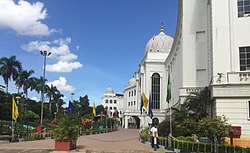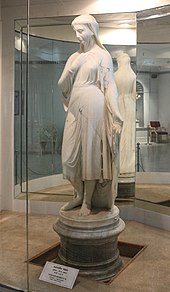Salar Jung Museum
Coordinates: 17°22′17″N 78°28′49″E / 17.371426°N 78.480347°E
Infobox | |
 The Salar Jung Museum building | |
 The Salar Jung Museum building | |
| Established | 16 December 1951 |
|---|---|
| Location | Dar-ul-Shifa, Hyderabad, Telangana, India |
| Type | Art Museum |
| Key holdings | Veiled Rebecca |
| Collection size | 1.1 million objects |
| Owner | Government of India |
| Website | www |
The Salar Jung Museum is an art museum located at Dar-ul-Shifa, on the southern bank of the Musi River in the city of Hyderabad, Telangana, India. It is one of the notable National Museums of India.[1] Originally a private art collection of the Salar Jung family, it was endowed to the nation after the death of Salar Jung III. It was inaugurated on 16 December 1951.
It has a collection of sculptures, paintings, carvings, textiles, manuscripts, ceramics, metallic artifacts, carpets, clocks, and furniture from Japan, China, Burma, Nepal, India, Persia, Egypt, Europe, and North America. It is one of the largest museums in the world.[2]
History[edit]
A nobleman of the Salar Jung family of Hyderabad, Nawab Mir Yousuf Ali Khan, Salar Jung III (1889–1949) served as Prime Minister of Hyderabad during the Nizam's rule. He spent a substantial amount of his income, over a period thirty-five years, collecting artefacts from all across the world.

After the Nawab died in 1949, the collections were left behind in his ancestral palace Diwan Devdi. The collection was formerly exhibited there as a private museum, named Salar Jung Museum, which was inaugurated by Jawaharlal Nehru on 16 December 1951.[3][4]
Old timers believe that the present collection constitutes only half of the original art wealth collected by the Nawab. His employees siphoned off part of it, since the Nawab depended upon his staff to keep a vigil.[citation needed]
In 1968, the museum shifted to its present location at Dar-ul-Shifa, and is administered by a Board of Trustees with the Governor of Telangana as ex officio chairperson under the Salar Jung Museum Act of 1961. Some more art pieces were lost or stolen during the shifting of the museum from Diwan Devdi to the present site.[5]
In 2003, the museum signed a memorandum of understanding with the National Mission for Manuscripts, and was declared a manuscript conservation centre.
In 2006, a fire broke out in an auditorium in the museum premises. However, it was quickly extinguished and none of the artifacts were damaged.[6][7] After the incident, fire safety facilities were upgraded.[8]
Collections[edit]
Indian[edit]
The "Founder's Gallery" houses portraits of Salar Jung III, as well as other members of the Salar Jung family.
The Indian block includes jade-crafted daggers[9] of Jahangir, Nur Jahan and Shah Jahan; and weapons belonging to Aurangzeb, Tipu Sultan, Muhammad Shah, Bahadur Shah and Abul Hasan Qutb Shah.[10][11]
Indian miniature paintings belonging to the Mughal, Rajasthani, Thanjavur and Deccan schools are displayed. Indian sculptures from the Gandhara and Chola periods are also displayed.
The museum also has a collection of modern Indian artworks from the Bengal school. Works by Raja Ravi Varma, Abdur Rahman Chughtai,[12] M.F. Hussain,[13] K.K. Hebbar, Rabindranath Tagore, Abanidranath Tagore[14] and Nandalal Bose are displayed.[10]
Western[edit]
In 1876 on a trip to France the unique "double sculpture " Mephistopheles & Margaretta sculpture was acquired by Salar Jung I. He also traveled to Rome where he purchased a marble statue called Veiled Rebecca.[15]
The Salar Jung family had a history of collecting art, and eventually the collection of art from Salar Jung I, II and III all ended up in the Salar Jung Museum.[16]
European Art from the British, French and Italian schools is displayed. Among the notable artists whose works are displayed are Canaletto, William-Adolphe Bouguereau and Francesco Hayez.[14][10]
The furniture collection includes pieces from the time of King Louis XIV and Napoleon. Salar Jung III collected about 43,000 artifacts and 50,000 books and manuscripts out of which only few are displayed in today's museum.[17][18][19]
Eastern[edit]
The Eastern block houses Japanese artworks, porcelain artifacts, samurai swords and sculptures from China, Japan, Tibet and Burma.[20]
Quran collections[edit]
The museum has a famous Quran collection, from around the world in different fonts and designs, called the Quran Written with Gold and Silver. There are many more collections of religious books, as well as Arabic Quran.[21]
Clocks[edit]
A variety and array of clocks greet the visitor in the clock room. There are ancient sundials in the form of obelisks to huge and modern clocks of the twentieth century. Others in the range vary from miniature clocks which need a magnifying glass to imbibe their beauty and complexity to stately grandfather clocks from as far away as France, Germany, Italy, Switzerland and Britain including the musical clock Salar Jung bought from Cook and Kelvey of England. Every hour, a timekeeper emerges from the upper deck of the clock to strike a gong as many times as it is the hours of the day. The clock is an antique.
The Salar Jung Museum possesses a good number of clocks collected from different European countries such as France, England, Switzerland, Germany, Holland etc. The variety includes the Bird cage clocks, Bracket clocks, Grandfather clocks, Skeleton clocks, etc. The museum is also having some good examples of the clocks of the contemporary period of Louis XV, Louis XVI, and Napoleon 1st of France. The most important clock which attracts the greatest number of visitors every day is, however, a British Bracket clock. It has got a mechanical device by which a miniature toy figure comes out of an enclosure and strikes the gong and then returns to the enclosure at each hour.[22]
The Indian Parliament has declared the museum an Institution of National Importance.
Coins[edit]
There is a collection of about 600 Coins back from VijayNagar dynasty to Bahmani empire, Moghul empire and Modern India. Few coins are 2300yrs old. Some Punch Mark coins from Kushan dynasty are also preserved. The coins are made of Silver, copper,lead and lead.[23]
Facilities[edit]
The museum building, semicircular in shape with 38 galleries, spread on two floors, displays only a part of the original collection. The ground floor has 20 galleries and the first floor has 18 galleries. The exhibits on different subjects are displayed in separate galleries. Each gallery is huge and has many artifacts on display including ones dating back to the 4th century. There are plans for a new Islamic Gallery, where Islamic artifacts and manuscripts of the Qur'an will be displayed.[24][25]
Apart from the galleries, there is a reference Library, reading room, publication and education section, chemical conservation lab, sales counter, cafeteria etc.[14][26][27]
Gallery[edit]
Mayur Pankhi in Ivory
Nandi 12th century CE
Arabic calligraphy (from the Quran)
Eka-Mukha Linga 4th or 5th century CE
Mephistopheles & Margaretta (sculpture) 19th century CE
The Veiled Rebecca: melody in marble
Garuda in Anjali Mudra 18th century CE
A view of Salar Jung Museum along with Musi River
See also[edit]
References[edit]
- ↑ [Book name: Footprint India By Roma Bradnock,ISBN 978-1-906098-05-6, p-1033]
- ↑ Dundoo, Sangeetha Devi (19 June 2014). "125 years of Salar Jung museum". The Hindu. ISSN 0971-751X. Retrieved 18 October 2018.
- ↑ "585 Rani Sarma, Diwan Deodi". www.india-seminar.com. Retrieved 6 August 2018.
- ↑ "Treasures of Salar Jung Museum - Salar Jung Museum".
- ↑ "Old timer's belief".
- ↑ "Major Fire Breaks Out in Salar Jung Museum". Arab News. 4 November 2006. Retrieved 18 October 2018.
- ↑ "Fire at world-famous Salarjung Museum - Times of India". The Times of India. Retrieved 18 October 2018.
- ↑ "Latest fire safety system for Salar Jung Museum soon". The Hindu. 2 December 2006. ISSN 0971-751X. Retrieved 18 October 2018.
- ↑ Staff Reporter (2 January 2013). "Jade evokes an old-world charm". The Hindu. ISSN 0971-751X. Retrieved 18 October 2018.
- ↑ 10.0 10.1 10.2 "Welcome to Salarjung Museum". salarjungmuseum.in. Retrieved 18 October 2018.
- ↑ Kotaiah, B. (7 February 2013). "Salar Jung Museum weaponry: armed to the hilt". The Hindu. ISSN 0971-751X. Retrieved 18 October 2018.
- ↑ "Lady lighting lamp - Abdur Rahman Chugtai - Google Arts & Culture". Google Cultural Institute. Retrieved 26 September 2018.
- ↑ "Seated lady - M.F. Hussain - Google Arts & Culture". Google Cultural Institute. Retrieved 26 September 2018.
- ↑ 14.0 14.1 14.2 "Galleries". Archived from the original on 15 May 2007.
- ↑ "Salar Jung Museum's 'Double Statue'". Live History India. 26 July 2019. Retrieved 10 February 2022.
- ↑ Ians (20 January 2019). "Salar Jung museum: How one man's art collection became a national treasure". Business Standard. Retrieved 11 February 2022.
- ↑ "Fire scare at Salar Jung museum". The Times of India. 4 November 2006. Archived from the original on 10 September 2011.
- ↑ "Metro City Times » Blog Archive » Explo re the Belum Beau". Archived from the original on 22 June 2011.
- ↑ "important Exhibits".
- ↑ Sripada, Krishna (31 August 2017). "An all-season destination". The Hindu. ISSN 0971-751X. Retrieved 18 October 2018.
- ↑ "events". salarjungmuseum.in. 2008. Retrieved 13 April 2012.
- ↑ "Clocks".
- ↑ Ifthekhar, J.S. (30 January 2015). "New coins gallery to open at Salar Jung Museum". No. Hyderabad. The Hindu Group. The Hindu. Retrieved 10 February 2022.
- ↑ Nanisetti, Serish (21 July 2018). "India's first Islamic Art Gallery soon". The Hindu. ISSN 0971-751X. Retrieved 18 October 2018.
- ↑ Akbar, Syed. "Salarjung Museum's art gallery to be world's biggest cradle of Islamic legacy & heritage - Times of India". The Times of India. Retrieved 18 October 2018.
- ↑ "'Salar Jung Museum impenetrable'". The New Indian Express. Retrieved 18 October 2018.
- ↑ Ifthekhar, J. S. (1 February 2013). "Salar Jung goes solar". The Hindu. ISSN 0971-751X. Retrieved 18 October 2018.

























